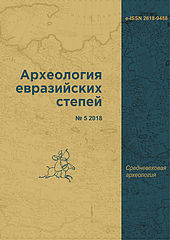FOOD AND FODDER IN THE MEDIEVAL CITY: ARCHAEOBOTANICAL MATERIALS OF THE BOLGAR HILLFORT
Keywords:
archaeobotany, food, fodder, Bolgar hillfortAbstract
Systematic archaeobotanical sampling began at the Bolgar' hillfort at 2011, the collection has now exceeded 200 samples, of which 85 have been investigated. The basic element of collection is the samples obtained as a result of fl otation of the cultural layer. The species composition of the crop plants found in them (millet, bread wheat, oats, emmer and einkorn, barley, fl ax, hemp) makes it possible to judge the structure of consumption of grain production in the city. The archaeobotanical spectrum simultaneously characterizes the everyday food of townspeople and forage products, intended for a small number of cattle kept in private estates, as well as horses – the main transport vehicle of the Middle Ages. It is practically impossible to distinguish between people's food and fodder in these materials. The grain accumulations from Bolgar, on the contrary, indicate not only the grain storage, processing or cooking, but also give a rare opportunity to assess that part of the agrarian products that was intended for animal feed. In some pits, grain was found in combination with straw (sometimes in the big volume), chaff , weeds and presumably with the remains of dung. Two variants of the interpretation of this composition of deposits on the bottom of the pits are suggested: either as litter
burned after cleaning the stables, or as storing forage stocks. No version explains completely such an unusual composition of samples, more detailed studies are required.
An additional source, marking the elite consumption of plant food by the Bolgar’ inhabitants, was the hand–piсked visual fi nds of imported fruits (grapes, peaches, fi gs, walnuts, almonds, olives, chickpeas).
References
Лебедева Е.Ю. Археобо таническая реконструкция древнего земледелия (методические критерии) // OPUS: междисциплинарные исследования в археологии. Вып. 6. М.: Изд-во «Параллели», 2008. C. 86−109.
Лебедева Е.Ю. Археоботаника: методы исследований и интерпретация результатов // Междисциплинарная интеграция в археологии (по материалам лекций для аспирантов и молодых сотрудников) / Отв. ред. Е.Н. Черных, Т.Н. Мишина. М.: ИА РАН, 2016. С. 118−146.
Туганаев, В. В., Ефимова, Т. П. К познанию состава возделываемых культур и сегетальной флоры Волжско-Камского региона в средневековье (IX–XV вв. н. э.) // Региональные флористические исследования. Под ред. проф. В.М. Шмидта. Л., 1987. С. 57−71.
Bakels C.C. Avoiding crop failure in the Iron Age: maslins and emergency crops on the loess soils of western continental Europe, with a special note on oat (Avena sativa) and foxtail millet (Setaria italica) // Bakels C.C., Kamermans H. (Eds.) The end of our fi fth decade / Analecta Praehistorica Leidensia. Leiden:
Faculty of Archaeology, Leiden University. 2012. Pр. 177−182.
Halstead P., Jones G. Agrarian ecology in the Greek islands: time stress, scale and risk // Journal of Hellenic Studies, 1989. Vol. 109. Pр. 41–55.
Jones G. The application of present-day cereal processing studies to charred archaeobotanical remains // Circaea. 1990 (for 1988). № 6. Pр. 91–96.
Jones G., Halstead P. Maslins, Mixtures and Monocrops: on the Interpretation of Archaeobotanical Crop Samples of Heterogeneous Composition // Journal of Archaeological Science, 1995. Vol. 22. Pр. 103–114.

Downloads
Published
How to Cite
Issue
Section
License
Copyright (c) 2018 E. Yu. Lebedeva

This work is licensed under a Creative Commons Attribution-NonCommercial 4.0 International License.







